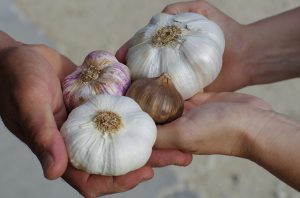By Sarah Bostick and Carol Wyatt-Evens
Gardening in Florida can be incredibly rewarding and incredibly frustrating, at the same time. If you are new to the region, you soon learn that gardening in the Sunshine State can quickly become a full-time job. While our subtropical climate is perfect for growing an abundance of different vegetables, fruits, and herbs, it also can present some overwhelming challenges.
We can help! UF/IFAS Extension Sarasota County agents and staff have created an online edible gardening resource center. The website features short videos from our 25-episode “Edible Gardening Series” webinars, along with blog posts and resources lists for episodes. Get help on an array of topics that befuddle many gardeners.
This week’s Question of the Week is:
Does garlic grow in Florida?
Good question! And the simple answer is this: kind of….and it depends.
If you have always wanted to try growing garlic in Florida or have tried and failed and want to understand why, here is what you need to know about growing garlic in Florida.

All garlic varieties need to experience cold day and night temperatures for at least a few weeks to actually produce heads of garlic. Some varieties need sub-freezing temperatures for a few months. For that reason, garlic isn’t typically grown in Florida. However, you can “trick” garlic into thinking that it has experienced winter by putting the cloves into the fridge for about two months and then planting the cloves in November or December.
Even with this simple method of providing your seed garlic with a dose of winter in your fridge, garlic simply is not as robust in Florida as it is in other regions of the country. Choosing the right variety is the key to success.
Choosing the right variety
There are a few different major categories of garlic and picking the right category and then the right varieties from the right categories is very important in our region. Here’s the basics on the different categories:

Hardneck garlic – this category of garlic literally has a hard stem (neck) emerging from the top of the garlic head. This category also produces a long, edible flowering stem called a “scape”. Hardneck garlic needs significant winter and simply doesn’t produce well – and in some cases, at all – in Florida.
There are nine sub-categories of hardneck: Asiatic, Creole, Glazed Purple Stripe, Marbled Purple Stripe, Middle Eastern, Porcelain, Purple Stripe, Rocambole, and Turban. There are dozens and dozens of varieties that fit into these nine sub-categories. If you live in Florida, these are the varieties to avoid.

Softneck garlic – this category of garlic has a soft stem (neck) emerging from the top of the garlic head. Softneck garlics no not produce scapes. This is the category of garlic used for making garlic braids.
There are two sub-categories of softneck, both of which are theoretically viable in our area: Artichoke and Silverskin. There are dozens and dozens of varieties that fit into these two sub-categories. If you decide to give garlic growing a try, plant softneck varieties that are from other hot, humid, sandy parts of the world. There are many softneck varieties that are from places like Oregon, New England, and Russia and they will not perform as well as softneck varieties from a climate more similar to Florida.
Elephant garlic – this massive garlic is actually not garlic! It is a leek. The flavor is somewhere between garlic and leek and it is just HUGE. It is really fun to grow and will grow well in most of Florida. It is is generally considered the best garlic option for Florida. There are only a few varieties to choose from. It is relatively expensive to get started growing elephant garlic because each head weighs about 1 pound and only produces about 4-5 cloves. Seed-quality elephant garlic is commonly sold for around $20/pound.
A few more garlic growing tips
- Read up about how to grow garlic before giving it a try. Here’s a great resource from the University of Georgia to get you started.
- Don’t start with garlic purchased from the grocery store. There is no guarantee that grocery store garlic will grow well in Florida, be disease-free, or be free of chemicals that prevent sprouting. Start with certified disease-free “seed garlic” from a reputable seed company or garlic farm that specializes in seed garlic.
- Be patient! Garlic is a slow-grower. Read up about how to know when garlic is ready to harvest – it takes a lot of careful observation.
- Remember to save some of your home-grown garlic for planting next year. One garlic clove = one new garlic plant. For most home gardeners, saving the biggest, healthiest head of softneck garlic provides plenty of cloves for next year’s garden.
And last but not least:
Have fun!! Learning to grow garlic in Florida is challenging but the results are well worth the effort.
The Edible Gardening Series and blog series is a partnership between the following UF/IFAS agents and Sarasota County staff:
- Sarah Bostick, Sustainable Agriculture Agent
- Carol Wyatt-Evens, Chemicals in the Environment Agent
- Mindy Hanak, Community & School Gardens Educator
- Kevin O’Horan, Communications Associate
 0
0
